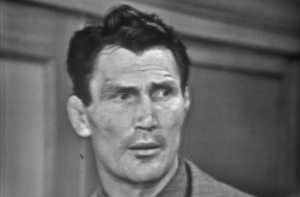Category Archives: Teleplays
No Laughing Matter: Serling’s “The Comedian”
The first time I saw “The Comedian,” I was astonished.
I knew it was one of a trio of works from the early days of live television drama that had earned Rod Serling his first three Emmys. But that was it. An avid Twilight Zone fan, I had watched the live version of “Patterns” (January 12, 1955), then “Requiem for a Heavyweight” (October 11, 1956), and immediately saw themes in these beautiful plays that would later emerge on his signature series.
Then I watched “The Comedian”.
Think Mickey Rooney is on fire in Twilight Zone‘s “The Last Night of a Jockey”? That episode plays like the warm-up act for his off-the-hook performance in “The Comedian” (February 14, 1957). Rooney is Sammy Hogarth, an old-school comic in the style of Milton Berle. He stages big TV specials packed with skits, monologues and musical numbers — and he makes life for his staff and family a living hell. Read the rest of this entry
Serling’s “Requiem for a Heavyweight”: A Knock-Out
When we think of The Twilight Zone, we naturally picture alien contact, time travel and other mind-bending occurrences. But if TZ offered little more than weirdness, would it have become such a classic? Would we be eagerly watching marathons decades later?
I don’t think so. A crucial element beats beneath its supernatural surface, one that helped make it a legend: a heartfelt concern for the little people.
Think of Henry Bemis, the mild-mannered bank teller who just wants time to read. Or Al Denton, the alcoholic gunslinger tormented by memories of a lethal shootout. Or Henry Corwin, the sad-sack Santa who longs to help the people in his poverty-stricken neighborhood.
The list goes on, but they all started with a man who made his debut on Playhouse 90 on October 11, 1956: Harlan “Mountain” McClintock.
Mountain takes center stage in “Requiem for a Heavyweight,” a live TV play that earned Rod Serling his second Emmy. “Patterns” had turned him into the proverbial overnight success, but a few middling follow-up dramas left some critics wondering if he was a flash in the pan. “Requiem” proved he was no one-hit wonder. Read the rest of this entry
Exploring “Morality’s Shady Side of the Street”
Sixty years ago today, the Kraft Television Theatre aired a repeat of Rod Serling’s teleplay “Patterns.” As a Twilight Zone fan, why should you care?
After all, this was four and a half years before TZ hit the air. And the program in question had nothing to do with aliens, time travel, or any of the other fantasy elements that made that classic series so famous. It was a straight drama. Yawn, right?
Not so fast. A few important factors make “Patterns” worth a second look, especially for Twilight Zone fans.
One is that it turned Serling into the proverbial “overnight success.” Without it, it’s fair to question if he’d have gained the clout to launch a certain foray into the fifth dimension. Read the rest of this entry
Serling’s “Patterns”: A Television “High Point”
Sixty years ago today, a live teleplay by a writer named Rod Serling aired on the Kraft Television Theatre. It was called, simply, “Patterns.”
There was no reason to assume it would be special. But by the time it went off the air an hour later, Serling’s reputation as a writer par excellence had been born. As New York Times critic Jack Gould put it:
Nothing in months has excited the television industry as much as the Kraft Television Theatre’s production of Patterns, an original play by Rod Serling. The enthusiasm is justified. In writing, acting and direction, Patterns will stand as one of the high points in the TV medium’s evolution.
That’s pretty high praise. But as Gould said, it was indeed justified. He went on to call for a repeat performance — an unusual suggestion in that era. After all, it would mean reassembling the cast and basically staging it all over again. But on February 9, 1955, that’s exactly what they did. Read the rest of this entry
From “Dust” to the Zone
Few Twilight Zone fans have seen “A Town Has Turned to Dust,” a live teleplay written by Rod Serling that aired on June 19, 1958. But if it weren’t for that show, the Zone might never have existed.
Specifically, it was the frustrating experience of trying to get it on the air intact that helped convince Serling that allegory, not straight drama, might be a better way to get his points across.
“A Town Has Turned to Dust” was based on the case of Emmett Till, a black teenager tortured and murdered by a group of white thugs in 1955 Mississippi. His offense: allegedly making some off-color remarks to a white female shop-keeper. Till was hunted down, beaten, shot and thrown in a river. This heinous crime shocked the nation, and led Serling to dramatize the events in “A Town Has Turned to Dust” for Playhouse 90.
But as Marc Scott Zicree and other biographers have noted, the show’s sponsors were nervous about offending certain customers, especially in the South. They pored over the script, demanding numerous changes (many of them quite petty). It morphed from a story about homicidal prejudice in the present-day Deep South, to one about a white murdering a Mexican in a U.S. southwest town in the 1870s.

The teleplay stars a young William Shatner, who would go on to star in two memorable Twilight Zone episodes.
“By the time the censors had gotten to it, my script had turned to dust,” the understandably irritated author later commented. “They chopped it up like a room full of butchers at work on a steer.” Read the rest of this entry







